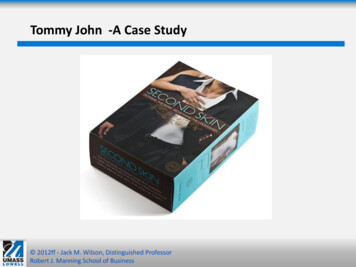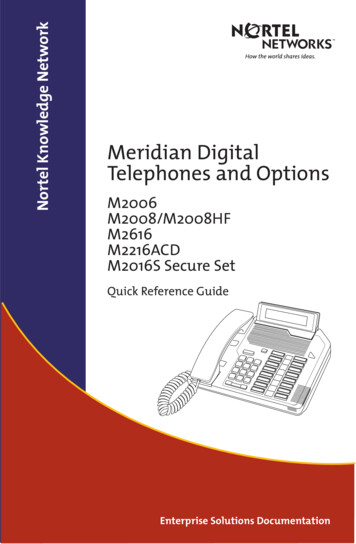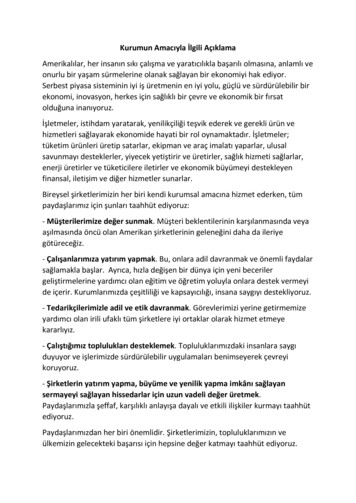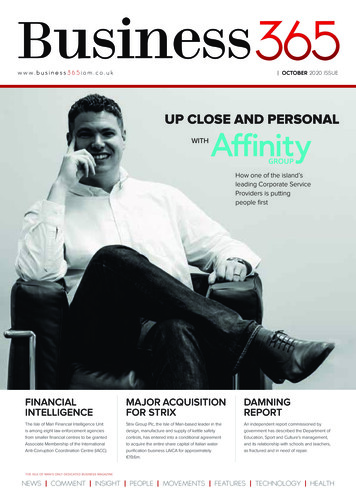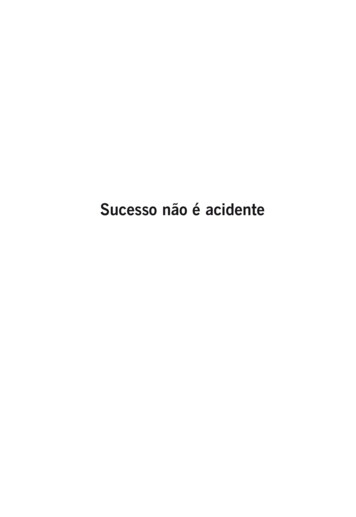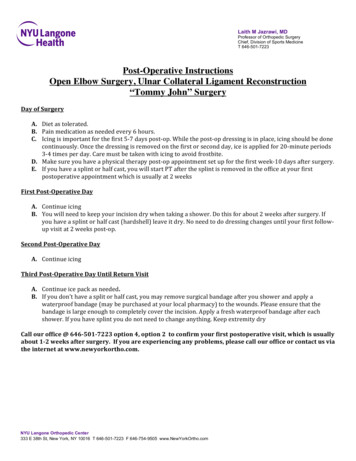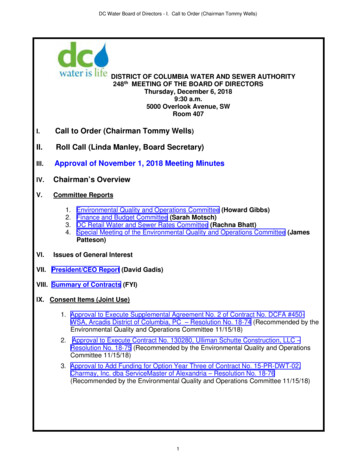
Transcription
DC Water Board of Directors - I. Call to Order (Chairman Tommy Wells)DISTRICT OF COLUMBIA WATER AND SEWER AUTHORITY248th MEETING OF THE BOARD OF DIRECTORSThursday, December 6, 20189:30 a.m.5000 Overlook Avenue, SWRoom 407I.Call to Order (Chairman Tommy Wells)II.Roll Call (Linda Manley, Board Secretary)Ill.Approval of November 1, 2018 Meeting MinuteslV.Chairman’s OverviewV.Committee Reports1.2.3.4.Vl.Environmental Quality and Operations Committee (Howard Gibbs)Finance and Budget Committee (Sarah Motsch)DC Retail Water and Sewer Rates Committee (Rachna Bhatt)Special Meeting of the Environmental Quality and Operations Committee (JamesPatteson)Issues of General InterestVII. President/CEO Report (David Gadis)VIIl. Summary of Contracts (FYI)lX. Consent Items (Joint Use)1. Approval to Execute Supplemental Agreement No. 2 of Contract No. DCFA #450WSA, Arcadis District of Columbia, PC – Resolution No. 18-74 (Recommended by theEnvironmental Quality and Operations Committee 11/15/18)2. Approval to Execute Contract No. 130280, Ulliman Schutte Construction, LLC –Resolution No. 18-75 (Recommended by the Environmental Quality and OperationsCommittee 11/15/18)3. Approval to Add Funding for Option Year Three of Contract No. 15-PR-DWT-02,Charmay, Inc. dba ServiceMaster of Alexandria – Resolution No. 18-76(Recommended by the Environmental Quality and Operations Committee 11/15/18)1
DC Water Board of Directors - I. Call to Order (Chairman Tommy Wells)4. Approval to Execute Contract No. 18-PR-DWT-38, Nutri-Blend Inc. – Resolution No.18-77 (Recommended by the Environmental Quality and Operations Committee11/15/18)5. Approval to Execute the Extension and AddFunding to Option Year Two of ContractNo. WAS-12-066-AA-RE, Polydyne, Inc. – Resolution No. 18-78 (Recommended bythe Environmental Quality and Operations Committee 11/15/18)X.Consent Items Non-Joint Use1. Approval to Execute Change Order No. 02 of Contract No. 150110, AmericanContracting & Environmental Services, Inc. – Resolution No. 18-79 (Recommended bythe Environmental Quality and Operations Committee 11/15/18)2. Approval to Publish Notice of Final Rulemaking to Expand the Customer AssistanceProgram (CAP) to Establish Rules for DC Water’s CAP2 Program, to Adopt Rules forImplementing the District’s CAP3 Program, and Not Taking Action on the District’sCRIAC Nonprofit Relief Program Pending Review of Department of Energy andEnvironment Implementing Regulations– Resolution No. 18-80 (Recommended by theDC Retail Water and Sewer Rates Committee 11/29/18)3. Approval to Modify Contract No. 15-PR-CCO-59, Vertex Business Service – ResolutionNo. 18-81 (Recommended by the Environmental Quality and Operations Committee12/05/18)Xl.Xll.Executive SessionAdjournment (Chairman Tommy Wells)1 The DC Water Board of Directors may go into executive session at this meeting pursuant to theDistrict of Columbia Open Meetings Act of 2010, if such action is approved by a majority vote of theBoard members who constitute a quorum to discuss: matters prohibited from public disclosurepursuant to a court order or law under D.C. Official Code § 2-575(b)(1); contract negotiations underD.C. Official Code § 2-575(b)(2); legal, confidential or privileged matters under D.C. Official Code §2-575(b)(4); collective bargaining negotiations under D.C. Official Code § 2-575(b)(5); facilitysecurity under D.C. Official Code § 2-575(b)(8); disciplinary matters under D.C. Official Code § 2575(b)(9); personnel matters under D.C. Official Code § 2-575(b)(10);proprietary matters underD.C. Official Code § 2-575(b)(11); decision in an adjudication action under D.C. Official Code § 2575(b)(13); civil or criminal matters where disclosure to the public may harm the investigationunder D.C. Official Code § 2-575(b)(14), and other matters provided in the Act.Upcoming Committee Meetings Finance and Budget Committee – Tuesday, December 18th @ 11:00 a.m. Environmental Quality and Operations Committee – Thursday, December 20th @9:30 a.m.22
DC Water Board of Directors - V. Committee ReportsDistrict of ColumbiaWater and Sewer AuthorityBoard of DirectorsEnvironmental Quality and OperationsMeetingThursday, November 15, 20189:30 a.m.MEETING SUMMARYDC Water Staff PresentDavid Gadis, President and CEOLeonard Benson, Chief EngineerHenderson Brown, General CounselLinda Manley, Secretary to the BoardCommittee MembersHoward Gibbs, Vice ChairpersonIvan FrishbergPatty BubarAnthony Giancola (teleconference)Jedd Ross (teleconference)I.CALL TO ORDERMr. Gibbs called the meeting to order at 9:30 a.m.AWTP STATUS UPDATESII.1.BPAWTP PerformanceMr. Aklile Tesfaye, Assistant General Manager for Wastewater Treatment reported the monthlyaverage influent flow was 316 MGD. There was 27 MG of treated captured combined flowdirected to Outfall 001 during this period.Mr. Tesfaye highlighted that during the month of October 2018, the Washington Metro Regionreceived below normal total rainfall (3.06 inches compared to 3.40 inches nominal). The wetweather event that occurred during the second week of October resulted in peak flows throughcomplete treatment exceeding 590 MGD. The Blue Plains Advanced Wastewater Treatment Plantperformance was excellent, and the event had minimal impact on the quality of the effluentdischarge through the outfall. All effluent quality parameters were below the weekly and monthlyaverage NPDES permit limits.During the month, a total of 146 MG of CSO captured in the tunnel system, was pumped andtreated using the Enhanced Clarification Facility (ECF). A portion of the treated flow or 119 MGwas directed to the main plant to maximize complete treatment and the remaining portion of thetreated, captured combined flow, or 27 MG, was disinfected, dechlorinated and dischargedthrough Outfall 001.111
DC Water Board of Directors - V. Committee ReportsThe Committee inquired as to why the 2019 sales goal for the Bloom product had increased from2018 since the previous years’ goals were not met. Mr. Gadis, replied that DC Water will look atthose projections more closely and make a recommendation.II.CIP QUARTERLY REPORTMr. Paul Guttridge, Manager, Program Services, reported on the Fiscal Year (FY) 2018 4thQuarter Capital Improvement Program (CIP). Mr. Guttridge stated that current projected CIPdisbursements through the end of September 2018, as 447,805,000 or 12.4% above thebaseline disbursement projection of 398,285,000.Mr. Guttridge stated that, although the actual disbursements over the last four years have beenon average 5% of the projection, DC Water has made certain enhancements to the waydisbursement projections are made and that these changes will be implemented for FY19.These include more detailed breakdown of Task Order work at Blue Plains, a more user-friendlyprocess for CIP updates, a closer inspection of historical performance and improved treatmentof how retention updates are handled.The Committee inquired if the nearly 50M disbursement variance poses an issue when itcomes to cash flow. Matthew Brown, Chief Financial Officer, replied that the Authority hasreserves that would mitigate the cash flow situation. The Committee also inquired as to howproject schedules were prepared. Mr. Guttridge replied that DC Water uses the Primavera P6scheduling software, that is used industry-wide. The CIP cost loaded schedule contains nearly7,500 individual activities that roll up to provide the disbursement projection. Activity data isprovided by project managers who are responsible for formulating and updating their projectschedules.Mr. Guttridge also briefed the Committee on the 6-month look ahead for significant contractactions.Mr. Guttridge next summarized the status of the CIP schedule Key Performance Indicators (KPI)as of the 2018 4th quarter. Of the 27 KPI’s, 22 KPI’s have been achieved and 5 KPI’s were notachieved within the threshold representing an 81% achievement rate which is an improvementon previous years. Mr. Guttridge identified the five that were not achieved to the Committee.III.ACTION ITEMSJOINT USE1.2.3.4.5.Contract No. 15-PR-DWT-02 – Industrial Cleaning Services, Charmay Inc.,Contract No. 18-PR-DWT-38 – Biosolids Management, Nutri-Blend Inc.,Contract No. WAS-12-066-AA-RE – Pre-Dewatering Polymer, Polydyne Inc.,Contract No. 130280 – Filtration Influent Pumps 1-10 Replacement, UllimanSchutte Construction LLC.,Contract No. DCFA 450 – Tunnel Dewatering Pump Station and EnhancedClarification Facility (Engineering Services SA2), Arcadis District of Columbia,PC.Mr. Joel Grosser, Category Manager – Procurement, DC Water presented joint use Action Items212
DC Water Board of Directors - V. Committee ReportsIn regards to the Biosolids Management contract, the Committee inquired if DC Water hadcommunicated to the Contractor that the base price of the contract (and therefore, the expectedamount of work by DC Water) is only 2 million even though the Contractor had submitted in abid quote of nearly twice that. Mr. Grosser replied in the affirmative.In addition, the Committee inquired as to the reason of the requested time extension. Mr. Bensonreplied that the contract scope required that tunnel performance tests be conducted with dataderived from three (3) rainfall events. The contract also assumed these events would occur withina 90-day period, which did not take place, thereby causing a delay. In addition, flooding in certainparts of the tunnel during construction, caused a delay.NON-JOINT USE1. Change order No. 02 of Contract No. 150110, American Contracting &Environmental Services, Inc.The Committee recommended all joint and non-joint use Action Items to the full Board.IV.SMALL DIAMETER WATER MAIN REPLACEMENT PROGRAM PRIORITIZATIONCRITERIAMr. Craig Fricke, Director of Engineering and Technical Services (DETS), DC Water, gave apresentation on the prioritization criteria used in the Small Diameter Water Main Replacement(SDWMR) program.Mr. Fricke concluded his presentation by summarizing past and current approaches to SDWMRprioritizationThe Committee inquired as to what, if any, impacts there would be to the budget due to theimplementation of InfoMaster in 2019. Mr. Fricke replied that there will be no new impacts to thebudget as the InfoMaster tool will conduct prioritizations within the scope of existing budgetparameters. The Committee also requested DC Water display the percentage of the differentrisk categories of pipes in its SDWMR Risk Prioritization maps.III.BLUE PLAINS RESEARCH AND DEVELOPMENT OVERVIEWMs. Christine deBarbadillo, Director, Department of Clean Water Quality and Technology(CWQT), gave a presentation on research and development activities at Blue Plains AdvancedWastewater Treatment Plant (AWWTP). The presentation began by listing some of thechallenges faced at Blue Plains including population growth, stringent environmentalregulations, space constraints, aging infrastructure, impacts to urban environment, energy andresource sustainability and cost.Ms. deBarbadillo stated the drivers/goals of the CWQT department were Supporting Operations byo Processing of related operational issueso Optimization and process development313
DC Water Board of Directors - V. Committee Reports Supporting CIP Planning byo Acquiring future permitso Due diligence for application of new processeso Process evaluation and development of design criteriaThe current CWQT staff consists of four (4) full-time, DC Water staff, researchassociates/interns and other collaboration partners. The department also has researchlaboratories at three (3) locations containing analytical equipment and capable of bench scaletesting. Some of the processes that are (have) being piloted include carbon and nitrogenremoval, thermal hydrolysis and anaerobic digestion. The Research and Development (R&D)focus areas of the CWQT department can be grouped as follows: Carbon Management – maximizing carbon capture in chemically enhanced primarytreatment and high-rate activated sludge systems. The main drivers for this R&D areaare:o Projected capacity issueso Need for reduction of energy consumption in secondary treatmento Need to promote additional energy recovery Nitrogen Management – minimizing carbon demand and increasing capacity withMainstream and Sidestream deammonification system. The main drivers for theMainstream and Sidestream treatment include:o Chesapeake Bay Enhanced Nutrient Removal (ENR) limitso Need to reduce high methanol costso Projected capacity issues Biosolids Management – maximizing energy recovery in Cambi digesters. The maindrivers for this R&D area include:o Quality (Class A) and Quantity of Biosolidso Need for energy recoveryo Projected capacity issuesThe Committee commended DC Water and Ms. deBarbadillo on the thoroughness of theinformation shared during the session.IV.ADJOURNMENTMeeting adjourned at 11:30 a.m.Follow-up Items1. President and CEO: Look into projected Bloom sales goals for 2019 and recommendadjustments as necessary.414
DC Water Board of Directors - V. Committee ReportsDISTRICT OF COLUMBIAWATER AND SEWER AUTHORITYBoard of DirectorsFinance and Budget CommitteeTuesday, November 13, 201811:00 a.m.MEETING MINUTESDC Water StaffDavid Gadis, President and CEOMatthew T. Brown, Chief Financial Officer (CFO)Len Benson, Chief EngineerHenderson Brown, General CounselPaul Guttridge, Manager, Program ServicesLinda Manley, Board SecretaryCommittee Members (via conference call)Timothy Firestine, Committee ChairpersonSarah MotschJed RossCall to OrderChairperson Timothy Firestine called the meeting to order at 11:00 a.m.October 2018 Financial ReportMatthew Brown, CFO presented the monthly financial report, noting that DC Water is on track, and in linewith budgetary expectations in all categories in the first month of the fiscal year. With approximately 8.3percent of the fiscal year completed, total operating revenues are at 67.2 million, or 10.4 percent ofbudget, operating expenditures at 44.0 million, or 7.6 percent of budget, and capital disbursements at 25.4 million, or 5.8 percent of budget.CFO Brown informed the Committee that the US Environmental Protection Agency invited DC Water toapply for a Water Infrastructure Finance and Innovation Act (WIFIA) loan for 144.0 million. DC Waterbundled 20 projects, called the “Comprehensive Infrastructure Repair, Rehabilitation and ReplacementProgram" in its submission to EPA. Mr. Brown stated the benefits of the WIFIA Loan Program wouldcover 49% of the project costs and the loan interest rate will be at the US Treasury rates. ChairpersonFirestine asked what are the advantages, and if loan will count against DC Water’s debt burden. Mr.Brown explained that the advantages of using the WIFIA loan program, is that it offers a financing termlonger than thirty years, and the long-term rates are cheaper than other methods.Next, Mr. Brown noted that a detailed fiscal analysis on the customer rates, level of borrowing, and otherfinancial metrics for the Capital Improvement Program (CIP) options will be presented at a specialmeeting of the D.C Retail Water & Sewer Rates Committee on November 29 th. Additionally, the budgetworkshop will follow the January 3rd Board meeting.15
DC Water Board of Directors - V. Committee ReportsCapital Improvement Program Quarterly UpdateMr. Paul Guttridge, Manager, Program Services, Department of Engineering & Technical Servicesprovided an update on the FY 2018 Fourth Quarter Capital Improvement Program. He stated thatFY 2018 actual disbursements for capital projects/construction were 447.8 million, which is 12.4% abovethe revised budget of 398.3 million, with overspending primarily in the following service areas:Wastewater Treatment, Sanitary Sewer, and Water. Mr. Guttridge mentioned the primary drivers inWastewater Treatment was due to how retention rates were established, and for Sanitary Sewer thedrivers due to under projected cost, to comply with National Environmental Policy Act (NEPA) and workdone for DDOT and the National Park Service. He informed the Committee that the team is currentlyassessing ways to better project spending, including work that is done on Blue Plains by providing adetailed task order, inputting actual spend into their program management system, having the ProjectManagers focus on completion dates, and reviewing historical performance levels and trends.Next, Mr. Guttridge provided an overview of the significant contract actions anticipated and an update onthe Key Performance Indicators (KPIs) in the CIP noting that 22 of the 27 KPIs were completed duringthe fiscal year. He explained the reasons for the remaining 5 KPIs that were delayed: St. Elizabeth WaterTank, abnormal weather conditions; Large Valve Replacement, conflicts with Washington Gas and Pepcoand an increase in scope; Potomac Interceptor - Phase II, regulatory mandates and design start delay;Small Diameter Replacement, unexpected night work for crews; and Blue Plains Pump Replacement,scheduling and sequencing issues.CFO Brown noted that the FY 2018 capital disbursement of 489.9 million was higher than the revisedbudget and mid-year projections. He reviewed the Cash Balance Report, highlighting that the FY 2018Board-approval of 18 million for Pay-Go financing was carried over into FY 2019 and will be appliedaccordingly. In response to Chairperson Firestine’s inquiry, regarding how the higher disbursements werepaid, Mr. Brown explained, that overspending in capital projects/construction was offset by 10 millionunderspending in capital equipment, 18 million in Pay-Go, and the remainder from the premiums onbond proceeds issued during the Spring of 2018.Management and committee members expressed their appreciation to Chairperson Tim Firestine’sdedication and service to DC Water as this was his last meeting Chairing the Finance and BudgetCommittee.AdjournmentHearing no further business, Chairperson Firestine adjourned the meeting at 11:20 a.m.16
DC Water Board of Directors - V. Committee ReportsDISTRICT OF COLUMBIAWATER AND SEWER AUTHORITYBoard of DirectorsDC Retail Water and Sewer Rates CommitteeThursday, November 29, 20189:30 a.m.MEETING MINUTESCommittee Members in AttendanceRachna Bhatt, ChairpersonTommy Wells, ChairmanHoward GibbsEllen BoardmanReverend Kendrick CurryDavid FrancoIvan FrishbergJed RossDC Water StaffDavid Gadis, President/CEOMatthew Brown, CFO/EVP Finance & ProcurementHenderson Brown, EVP Legal AffairsLinda Manley, Secretary to the BoardVia Telephone:Anthony GiancolaKrystal BrumfieldCall to OrderChairperson Rachna Bhatt convened the meeting at 9:41 a.m.Customer Assistance Program Expansion Update (Attachment A)Mr. Brown, CFO/EVP gave an overview of the Customer Assistance Program and stated that DC Waterwill seek the Committee’s recommendation to the full Board for approval of the Customer AssistanceProgram (CAP) Expansion. He noted that the 6 million CAP2 program which is funded by DC Water’sRates Stabilization Fund (RSF) includes 0.5 million for administrative cost and that he anticipates thatthe District Department of Energy and Environment (DOEE) will contribute 1.2 million to the CAP2program. He noted that there are two administrative functions in the Notice of Proposed Rulemaking(NOPR) that DC Water is asked to perform: 1) CAP3 program, 2) Clean Rivers Impervious Area Charge(CRIAC) Non-Profit Relief program. He requested the Board to have an executive session after hispresentation, to receive privileged information that might have legal ramifications.Mr. Brown, CFO/EVP updated the Committee on the history of the CAP program. He noted that Districtcode § 34-2202 mandates that DC Water offer financial assistance programs to mitigate the impact ofany increases in retail water and sewer rates and the CRIAC on low-income residents. He noted that in17
DC Water Board of Directors - V. Committee ReportsFY 2014, the Board adopted General Principles of Affordability for Low-Income Customers which required“consideration of rate impacts on low-income customers” and exploration of affordability alternatives forlow-income customers. He stated that DC Water has taken several actions to help reduce the cost of theClean Rivers Program: 1) issued century bonds, 2) extension of the consent decree timeline, and 3)regular reviews of the CRIAC rate. He mentioned that in FY 2016, the Board directed the GeneralManager to: 1) evaluate the CAP and recommend expansion of CAP to include CRIAC; 2) review theimpact of CRIAC on various customer segments including low-income customers who do not qualify forCAP and to report findings by December of 2016; and requested the Finance and Budget Committee toreview the policy governing use of the Rate Stabilization Fund (RSF) to reduce or moderate or eliminatethe impact of CRIAC increases on ratepayers, particularly ratepayers eligible for CAP. Mr. Brown,CFO/EVP mentioned that in FY 2017 the Retail Rates Committee approved recommendation to expandCAP to include 50 percent off of the CRIAC; and postpone Phase 2 of CRIAC restructuring until afterVertexOne implementation in November 2017 to address low-income residential customers not eligiblefor CAP. He stated in FY 2017, Board approved resolution #17-18 CAP revisions for 50 percent CRIACreduction. He noted that in FY 2018 the Retail Rates Committee approved for FY 2019 a 13 percentincrease for water and sewer rates, 5.9 percent overall increase in the average household bill and adecrease in the CRIAC from 25.18 to 23.00 per Equivalent Residential Unit (ERU). Mr. Brown,CFO/EVP informed the Committee that in FY 2018 the Retail Rates Committee reviewed projected rateincreases and the proposed Cost of Service Study, reviewed Rate Policy Options and the RSF anddirected the General Manager to recommend changes to CAP to address customers not eligible for CAP.He noted that in FY 2018 the Retail Rates Committee reviewed and approved CAP Expansionrecommendation.Mr. Brown, CFO/EVP briefed the Committee on the low-income statutory mandate. He noted that DCWater’s regulations do not define “low-income”. He stated that the CAP eligibility is based on DOEE LowIncome Home Energy Assistance Program (LIHEAP) up to 60 percent of State Median Income (SMI)depending on the number of people in the household. Mr. Brown, CFO/EVP mentioned that there areother definitions of low-income. He stated that the District defines low-income as a household or familywhose annual income is greater then fifty percent (50%) but less than eighty percent (80%) of the AreaMedian Income (AMI) adjusted for family size. He stated that a Federal government defines low-incomeas income not in excess of 80 percent of AMI. He noted that a Housing of Urban Development (HUD)Memorandum explains “Uncapped” Income limits for 2018 and authorizes the District to use “uncapped”limits for annual median income. He mentioned that the District’s Home Purchase Assistance Programuses the uncapped AMI limits. Ms. Boardman asked if DC Water program is unlawful because it uses adifferent definition for low-income. Mr. Henderson Brown, EVP Legal Affairs replied that when engagedin the rulemaking capacity, if there is a rational reason and an explanation for the purpose of why wechoose a particular method, and someone else has a contrary view, as long as our decision is supportedby evidence then the courts will be very reluctant to change the final decision. He noted that DC Wateris using the accepted low-income definition used by the District agencies and Federal government for theexpanded CAP.Mr. Brown, CFO/EVP briefed the Committee on resolution #18-57. He noted that the resolution directedthe General Manager to: 1) transfer 6.0 million from the RSF to assist low-income residential customers;2) adding more low-income customers using metrics; 3) serve customers with household income up to80 percent AMI; 4) expand new benefits accorded by the CAP up to three Ccf of water and sewer servicesand percent discount on the CRIAC, include caps in the proposed recommendation on the number ofparticipants to ensure that the cost does not exceed 6.0 million; and 5) include other suggestionsdeemed necessary by the General Manager.Mr. Brown, CFO/EVP briefed the Committee on the program definitions. He noted that DC Water’sexisting CAP program uses LIHEAP criteria to provide DC Water funded discounts to low-incomeresidential customers with income up to 60 percent SMI. He mentioned that the proposed DC Waterexpanded CAP2 program is for low-income residential customers who do not qualify for CAP withhouseholds up to 80 percent AMI. He stated that the proposed new District’s CAP3 program is to provide218
DC Water Board of Directors - V. Committee Reportsbenefits to DC Water customers with household income greater than 80 percent and up to 100 percentAMI who do not qualify for CAP and CAP2. He stated that the proposed new CRIAC Non-profit ReliefProgram provides CRIAC credits to non-profit organizations as determined by the DOEE.Mr. Brown, CFO/EVP updated the Committee on the DC Water and District CAP programs. He notedthat the existing CAP program serves low-income residential customers up to 59,457, CAP2 serves lowincome residential customers up to 93,750 and CAP3 serves low-income customers up to 117,200.He stated that the benefits depend on the program. He mentioned that existing CAP program providesup to 4 Ccf of water and sewer discounts. The existing CAP program waives up to 4 Ccf of water andsewer, waives the Water System Replacement Fee (WSRF), and provides a 50 percent discount on theCRIAC.Mr. Brown, CFO/EVP mentioned that the proposed CAP2 program provides up to 3 Ccf of water andsewer discounts and 50 percent discount on the CRIAC. He stated that CAP2 benefits will be providedto eligible households retroactively from October 1, 2018 provided customers submit their completeapplication to DOEE before March 1, 2019. He mentioned that applications submitted on or after March1, 2019 will receive benefits as of the month of submittal to not more than the entire fiscal year, subjectto availability of funds. He stated that the average monthly discount is 43.48 (3 Ccf of water and sewerand 50 percent off one ERU), DC Water can serve approximately 10,541 customers. He mentioned thatthe CAP2 program is funded for one year through September 30, 2019. The CAP2 program will becapped at 6.0 million, 5.5 million in benefits to customers and up to 0.5 million for administrative costs.The District will contribute 1.2 million in additional funds for this program. He stated that when the levelis reached the program will be discontinued. Ms. Boardman asked how many customers are served underthe existing CAP and proposed CAP3 programs. Mr. Brown, CFO/EVP replied that between three andfour thousand customers are served under the existing CAP program and 4,900 customers are projectedto be served under the proposed CAP3 program.Mr. Brown, CFO/EVP stated that the CAP3 residential program will provide benefits of 75 percent off themonthly CRIAC to households with income at or above 80 percent AMI and below 100 percent AMI. Hementioned that the CRIAC Non-profit Relief Program will provide benefits of up to 90 percent off of thebilled CRIAC charges, provided retroactivity for the entire fiscal year and must reapply to continuebenefits. He noted that the eligible non-profits must: 1) successfully obtain status as a non-profit, 2) showsignificant financial hardship, 3) comply with on-site and off-site stormwater mitigations Best ManagementPractices (BMP) and 4) allow DOEE to visit the site of the organization. Chairperson Bhatt asked whoprovided the financial hardship criteria for religious and non-profit organizations. Mr. Brown, CFO/EVPreplied that the financial hardship criteria came from DOEE. He stated that the Budget Support Act (BSA)indicates an organization must have a significant hardship and the BSA directed the Mayor to establishwhat constitutes a significant hardship. He noted that the information provided by DOEE specified thatsome organizations meet one criteria and others meet another. Ms. Boardman inquired if DC Waterknows the basis of which hardship is being determined for non-profit applicants. Mr. Brown, CFO/EVPreplied that draft regulations provided by the District specify that organizations established under D.C.code §47-1002 section 12 or 47-1002(13)(14) or (15) annual CRIAC must be at least 0.75 percent of theorganization’s annual revenue less expenses and for organizations that have a tax exemption underorher parts of the code the CRIAC must be 5 percent of the organization’s annual revenue less expenses.Ms. Boardman asked why is there a difference between differing groups in the non-profit community andhave we inquired about why there is a difference. Mr. Brown, CFO/EVP replied that this is the Districtgovernment program and they established the requirements and will provide the funding. He noted thatwhen this Committee met with members of DOEE that question was posed to them. Mr. Brown, CFO/EVPstated that he has not had a conversation with DOEE about the differing requirements used for the nonprofit organizations.In response to Ms. Boardman’s question, Mr. Brown, CFO/EVP updated the Committee on the publichearing testimony comments. He stated that no written comments were received during the publichearing comment period. He provided an overview of the testimony comments: 1) DC Water’s shifts from319
DC Water Board of Directors - V. Committee ReportsDOEE’s LIHEAP measurement of low-income namely 60 percent of Health and Human Services (HHS)SMI but with no explanation or justification shifts not just to 80 percent of Housing and UrbanDevelopment (HUD) AMI level but to the uncapped HUD AMI rather than the capped level used by HUD.DC Water replied that the record before the Board supports its decision to expand the CAP program to80 percent AMI for the one-year program; 2) Rules on benefits and eligibility criteria that DOEE has notactually published
2. Contract No. 18-PR-DWT-38 Biosolids Management, Nutri-Blend Inc., 3. Contract No. WAS-12-066-AA-RE Pre-Dewatering Polymer, Polydyne Inc., 4. Contract No. 130280 Filtration Influent Pumps 1-10 Replacement, Ulliman Schutte Construction LLC., 5. Contract No. DCFA 450 Tunnel Dewatering Pump Station and Enhanced
